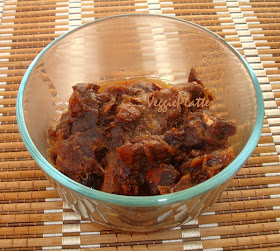
Tamarind is a pantry staple in Indian homes and like many other cultures of the world, the mature pods of this fruit are prized in Indian cuisine for their characteristic sweet-sourness. It happens to be one of the souring agents extensively used there, the others being lemon juice, kokum and amchur. It is a mandatory item, especially in south Indian cooking whose daily fare like sambhar, rasam (the lentil stews which are their main protein source) or the special rice dish "Pulihora / Puliyogare" depend on it. And so preparing tamarind puree / thick tamarind juice from tamarind pods is such a mundane thing in Indian kitchens that I never thought of dedicating a post towards it. :) When I am doing "Preps & "Preserves" duing this week of BM#11, I however thought of recording this simple process for those who are not familiar with Indian cuisine or new to tamarind. It is a lot easier, cheaper and moreover fresher than the store bought tamarind concentrate. Somehow I think the store bought stuff turns our dishes darker and tasteless.
I grew up in a time and region in India where huge tamarind trees on either side of the roads was norm. We like many households used to buy tamarind in bulk (atleast a few kilograms) and store. I remember my mother used to avoid buying the dark colored tamarind since it lent a dark color to our pulusu / sambhars.

Now here, I have no control over the quality or color and have to shell out $2 + tax for a small block of tamarind like the one pictured above and the worst part is that it is not as much sour as I wish it to be. No wonder, I am mad each time I see and buy those tamarind blocks here. In India though the tamarind is found in free form, here the Indian grocers sell the tamarind in those compressed blocks. In USA, tamarind can be brought at Indian grocery shops or Asian / Hispanic aisles of supermarkets. The Indian store kind tamarind is usually with fibrous membrane and seeds still present but with no shell. It therefore is easier to make the tamarind puree in a jiffy.

The tamarind needs to be soaked in water to soften the pulp for easy extraction of the puree. Removing the membranes and seeds is optional since they are discarded at the end anyway. However you wish to seperate them before soaking it in water, feel free to do so. Usually tamarind puree is prepared in Indian kitchens on a daily basis or whenever needed since usage of fresh ingredients is asserted in Indian cooking.
Usually about a lemon sized ball of tamarind is soaked in water until it softens. Add enough water so that all the tamarind is below the water surface. What I do usually is wash the tamarind, add water to it and nuke the bowl in a microwave for 2 - 3 minutes. I throw away the water used, add fresh water and rinse away the bits of shells any present.

Let there be some water in the bowl. Now take handful of softened tamarind pulp and keep rubbing and squeezing to separate it from the membranes and the seeds. Usually Indians use only their right hands for this job. Yes that is my right hand and I learnt that day that it is not easy to take a picture with your left hand.

As you keep rubbbing the tamarind pulp between your fingers or in your fist, the purée will seep through your fingers while the veins, seeds and membranes stay in your hand. (Usually I have the tamarind in on my four fingers and squeeze it with my thumb as in the picture.) You can just keep that veins and all that unwanted stuff aside and continue to repeat the process with the remaining pulp. Some also run the soft pulp through a sieve to filter out the puree.
You can add a little water if needed to the stuff you kept aside earlier and squeeze again to get as much puree as possible. The idea is to extract as much puree as possible. Discard the membranes, seeds and the veins.

Note:
1. The consistency of the puree depends upon the dish you are using it in. A little watery ones is fine for the sambhars / rasams while thick puree is needed for pulihora or tamarind chutneys.
2. This can be refrigerated for about 2 - 3 days and has to be dscarded after it.
Check here to know what my fellow marathoners have come up with.
Comments
lol, cant imagine tamarind pulp and photography
ReplyDeleteYes having this ready always, makes it so easy to get the dish done!
ReplyDeleteI usually go for steam cook to make a smooth tamarind puree and extract them later, urs version sounds prefect too..
ReplyDeleteEven now I buy tamarind in bulk and store it for the whole year. Very useful post for those who are new to the tamarind..
ReplyDeleteThis is def very useful suma
ReplyDeleteLike Priya, I also pressure cook , grind, filter and refrigerate the extract!
ReplyDeleteI totally agree with you on the quality of store bought tamarind extract and also the tamarind available in the stores in US. So I always get a good amount of tamarind from India :)
very useful post..I rub the soaked tamarind through the soup strainer.it also give nice pulp.
ReplyDeletepressure cook is what I do, and if I am pressed for time, do use storemade extract (dabur has a good version). I read somewhere that extracting tamarind pulp through hand is one of the best muscular workouts for a lady, esp against Carpel Tunnel Syndrome !
ReplyDeleteI have moved on to readymade tamarind paste because of my laziness :D!
ReplyDelete